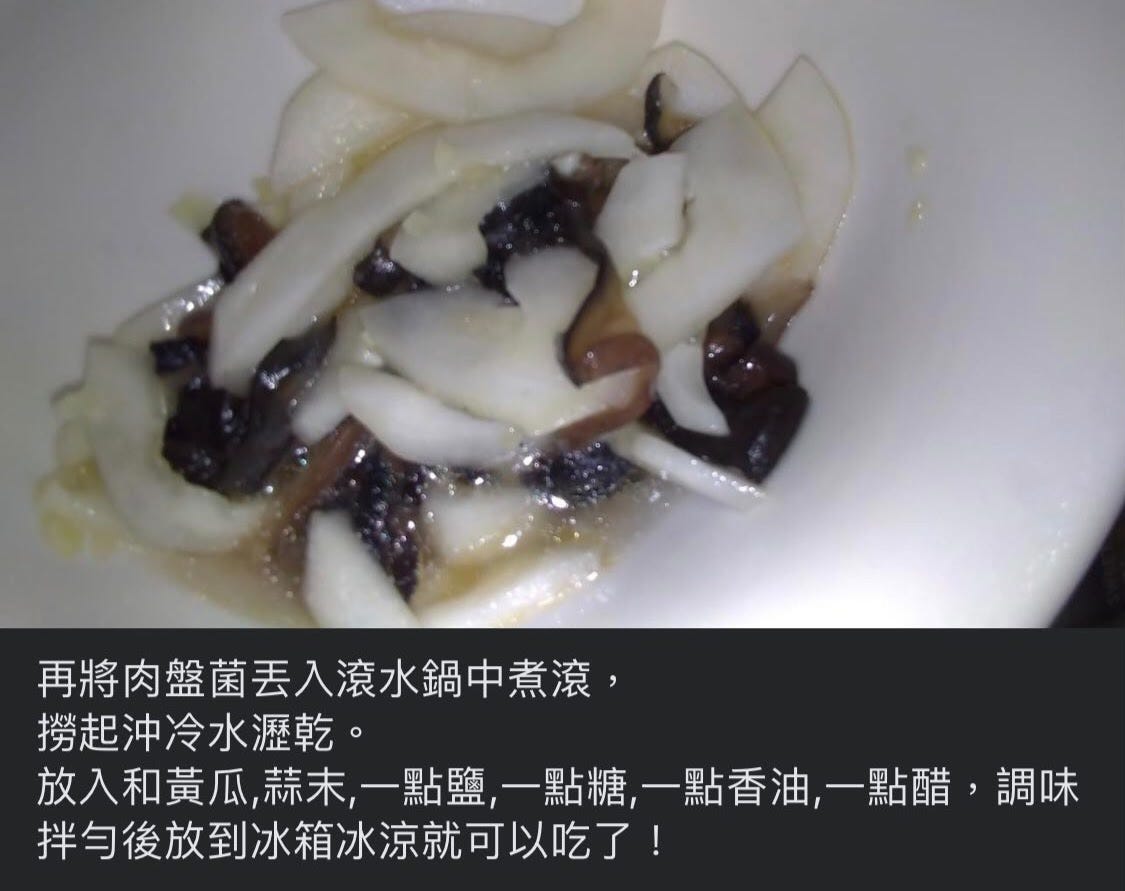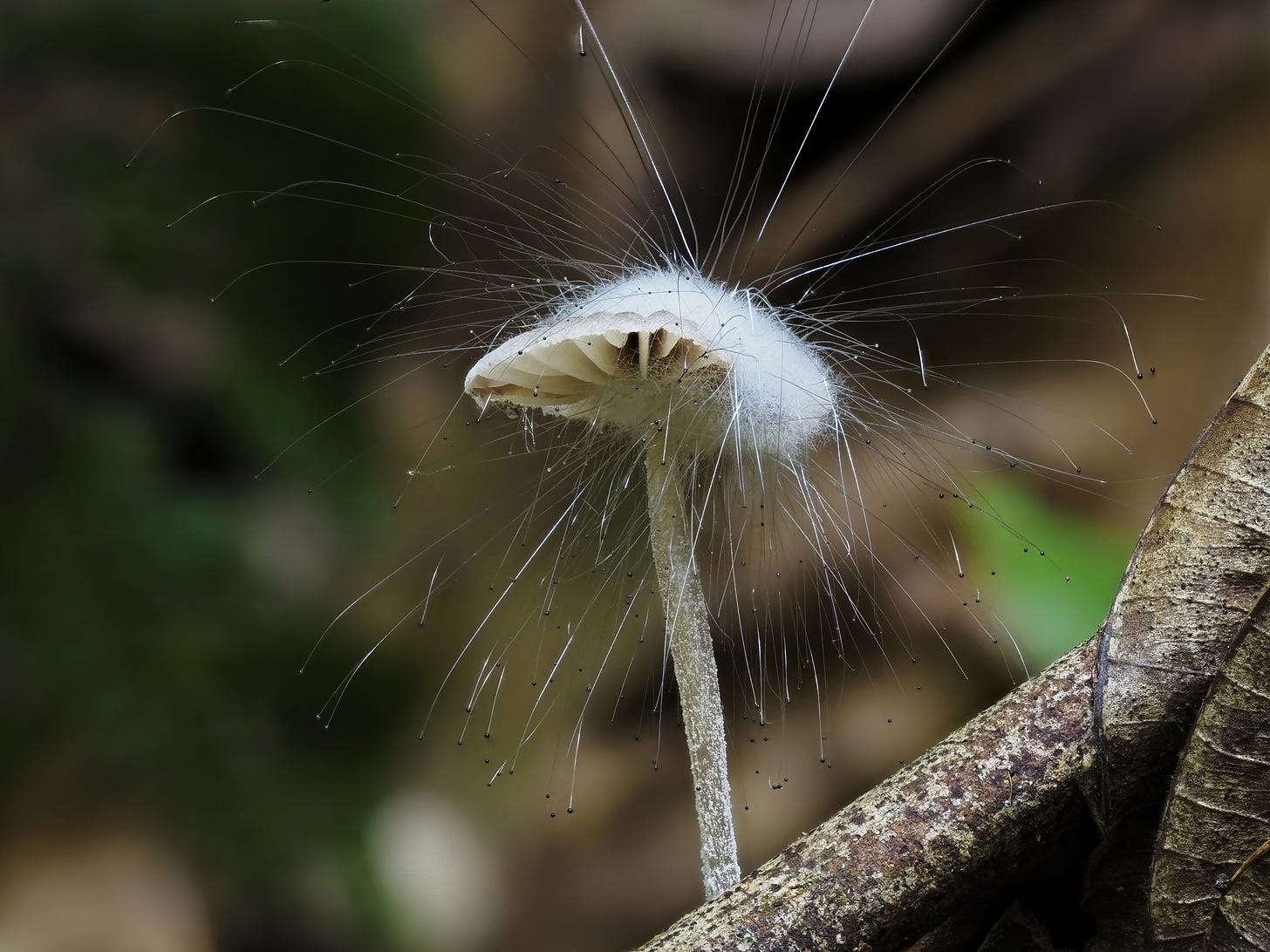A Sandworm, Stinkhorn, Staticky Bonnet Mold, and a Dead Man's Foot
More weird mushroom finds in Kuala Lumpur this past week.
Some interesting finds were provided by a couple more trips out to Kiara Hills and an afternoon walk around the KL Eco Forest Park this past week.
Failed attempts at capturing luminous porecaps, like the ones from last week, left me wondering what impact temperature, environment, and growth stage have on bioluminescence. Although I couldn't capture glowing mushrooms, I still found some pretty wild species.
Trichaleurina javanica
Trichaleurina javanica is a fleshy and rubbery goblet-shaped mushroom, brownish-gray in color with a brilliant yellowish-orange disc.
It reminds me of a Sandworm from the movie Dune. I reckon Frank Herbert would appreciate this one, given he was also a mycophile.
Known to go on mushroom forays, Herbert was inspired by and incorporated aspects of fungi into his writing. For example, spores and 'Melange' or spice, the blue-staining prevalent in magic mushrooms (psilocybin species), and the blue eyes of his characters.
Trichaleurina javanica, also known as "Ice Apple Mushroom," is found in Africa, the Saurashtra regions of Western India, Malaysia, Indonesia, West Java, Taiwan, and Hong Kong. One observation was made in Seychelles and the Philippines, and there have been a couple of observations up in northern Queensland, Australia.
It's known as 'Mata Rusa' (deer eyes) in Sabah, by Dusuns, and 'Mata Kerbau' (buffalo eyes) in Sarawak, Malaysia, and is consumed and prized in the market. In India, the mushroom is consumed raw by the Oorali tribe of the Sathyamangalam forest, and it's not reported as edible in any other part of India.
According to this paper, “it is reported that the copious gel of T. javanica, known in Madagascar under the common name Ranomatonantibary meaning “tears of an old woman,” was used to treat ophthalmia (inflammation of the eye) among the Betsimisarakas people.”
I chatted with a Taiwanese friend who mentioned that T. javanica is eaten in Asia.
Translated recipe:
Put the mushrooms in a pot and bring the water to a boil.
Drain and rinse with cold water.
Add cucumber, minced garlic, a little salt and sugar, sesame oil, and vinegar.
Mix well and put in the fridge to cool, then eat.
Looks…appetizing?…
Phallus luteus
When I first got to Kiara Hills, I spotted a stinkhorn (Phallus luteus), a different colored veil from the common stinkhorn (Phallus impudicus) I came across in Scotland. The "bridal veil" is orange.
Stinkhorns are known for their foul-smelling, sticky spore masses, or gleba, borne on the end of a stalk called the receptaculum.
Compounds found in feces and rotting flesh (carion) provide evidence of a scent profile that mimics fly brood sites and food sources that lure flies, beetles, and other insects into helping disperse spores.
One popular species, Phallus indusiatus or "bamboo fungus," is eaten as food in southwestern China after the foul-smelling cap is removed.
Families of monkeys hang out on the sides of the track, and I continue down to the river. Google Maps labels it as 'A Sungai (River) Runs Through It.' Down by the 'sungai,' I spot a fuzzy parasitized Mycena infected with bonnet mold. It reminds me of static hair after you rub a balloon on your head.
Spinellus fusiger
Spinellus means little spike or thorn, while the specific epithet fusiger means 'like a spindl'e.
Spinellus fusiger grows throughout the cap of the mushroom host, eventually breaking through to produce radiating reproductive stalks (sporangiophores) bearing minute, spherical, terminal spore-containing structures called sporangia.
While many mushrooms are noticeable and have striking features, some are unassuming and hidden, such as the "dyeball" or "dead man's foot."
Pisolithus arhizus
Pisolithus comes from two Greek words: Piso- meaning a pea, and lith meaning a stone, while the specific epithet arhizus means 'having no roots.'
I found a few of these small potato-like growths embedded in sandy mud under a Eucalyptus tree.
It's not the most aesthetically pleasing and is commonly referred to as the dog turd fungus. It is known in Australia as the horse dung fungus, in South Africa as perdebal, and Europe as the Bohemian truffle.
This inedible puffball's black viscous gel is used as a natural dye for clothes. It’s also a major component in mycorrhizal fungus mixtures used in gardening as powerful root stimulators.
Like clockwork, at around 4, I feel it spit, clouds darken, and the downpour suddenly starts. Monsoon season should be coming to an end. While the rains provide ideal conditions for mushrooms, getting caught in them cuts the forays short, but I'm glad I get the opportunity to observe what weird oddities nature offers.
Umbrella in hand, I make my way out of the park towards the metro when I hear my name. At first, I think I'm hearing voices in my head, but then I turn around to meet a couple of locals who have read this Substack and have seen some of my posts made in the local FB group and Instagram. Small world!
We exchanged contact info and agreed to meet a few days later and go on a foray at the Taman Tugu trails, a 66-acre “green lung” right in the heart of KL. It was an excellent time, and I will share what we found in the next newsletter.












Loved this series... cool fungi pictures!!
Great article. Very interesting and some cool pictures!